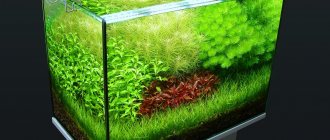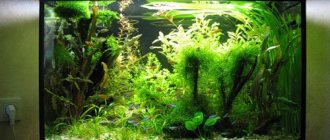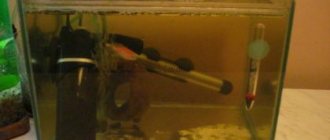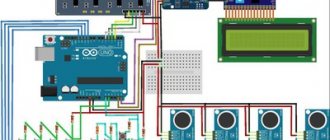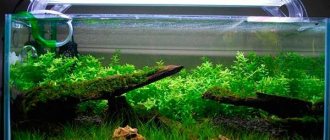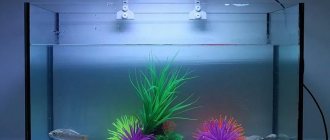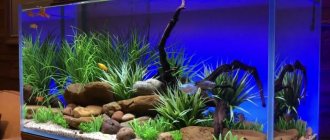General characteristics of aquarium light
The main characteristic of aquarium lighting is power. You need to start by determining the correct lighting power. As you know, power is measured in Watts (W). There is a special calculation of lighting power depending on the volume of the aquarium.
Lumen (Ln) - using this unit of measurement, the amount of light that the lamp emits is determined.
Another characteristic of lamps is color temperature (K). Only the sun provides the full light spectrum of illumination, it consists of waves that in their combination produce yellow or white light.
But if you separate them, they will have different colors. Many aquarium lamps have parameters of 5500K, 6500K, 10000K, 20000K. This is their color temperature.
It is not recommended to choose lamps with a color temperature below 5500K. Because their blue-red rays promote the growth of algae.
If you have a shallow freshwater aquarium, you should pay attention to 5500-10000K lamps. Lamps over 10,000K have a very high light intensity and are only used for deep aquariums.
Spectrum (Nm). For aquariums, 2 narrow spectral ranges are used: blue-green (440-470 Nm) and red (660 and 700 Nm).
Types of lamps
There are two types of lamps - closed and open. They differ in their design, since in the first version the lighting fixture is attached to the lid and is made as one element. Open type – the lamp is mounted above the water.
As a rule, closed lamps are made of plastic, and LEDs are used as a lighting element. The main thing is that they effectively illuminate every centimeter of the aquarium.
An open lamp has many advantages:
- It dissipates heat perfectly;
- Creates a natural lighting effect, highlighting fish and plants.
Typically, halogen lamps are used in such designs.
Sources of light
Lighting sources for an aquarium are:
- natural;
- artificial.
Is a natural source necessary?
Natural is daylight , it is used as an additional stimulation for the growth of aquarium plants and during fish spawning.
IMPORTANT! It is not recommended to install the aquarium in a place that is exposed to constant sunlight. Sunlight is an excellent stimulus for the growth of green algae.
At the moment, there are many types of artificial lighting. For aquariums are used:
- incandescent lamps;
- LED bulbs;
- fluorescent lamps;
- energy-saving lamps;
- special professional light sources
Incandescent lamps
Rarely used due to the availability of a more economical and effective alternative.
However, in aquarium farming they are used due to the fact that their spectrum is as close as possible to natural light. But this lighting device has a very low efficiency and many incandescent lamps are needed to grow aquarium plants. A large number of lamps will generate a lot of heat, which can negatively affect the aquarium climate and water balance.
LED modules and strips
Quite expensive, but more efficient lighting.
Aquarists often use them in combination with energy-saving lamps. LED lamps have low power. And they are often unable to provide large aquariums with sufficient light on their own.
However, high-power LED bulbs have begun to appear on the modern market, which over time may find wide application in the world of aquarium keeping.
Fluorescent lamps
Most commonly used in the aquarium world. Their advantages are considered to be cost-effectiveness and a fairly long service life.
Energy saving
Gaining popularity among aquarium lovers. Their use in lighting helps save energy and helps achieve optimal lighting conditions. These lamps have high light output, so two or three 18-20 W bulbs are enough to illuminate a 150-200 liter aquarium.
Special light sources are used in professional aquariums . These lamps can have a specific light spectrum, selected for a specific type of aquarium and plants.
All lighting options can be made with your own hands. There are many videos on this topic. Here is one of them:
Daylight hours and control options
For the harmonious operation of the aquarium, it is necessary to correctly determine the daylight hours. Lights must be turned on according to a schedule and for a certain number of hours . The optimal duration of daylight hours is within 8-10 hours. For herbal aquariums it can be 12 hours.
There are special devices for monitoring daylight hours. These are time relays or timers. They are electrical and mechanical. Using these devices, the lighting in the aquarium is automatically turned on and off.
In principle, night lighting is not required; it can be used only for beauty and when to turn it on is up to you. If your light bulbs stop shining, repairs will not be difficult . Usually this problem is solved by buying a new one.
Video
Light in a planted aquarium
Light in an aquarium with plants. The right light in the aquarium.
How to choose a lamp for a planted aquarium
How to give plants bright colors. Lighting, light in the aquarium. Lamps for aquarium plants
Intensity calculation
There are various methods for calculating light intensity for aquariums. The main ones:
- selection by volume;
- selection by depth.
Selection by volume
Selecting lighting according to the volume of the aquarium is quite simple. We must assume that 1 liter of water requires 0.5 W of power. And then, using simple mathematical operations, you can calculate the required power of lighting devices for your aquarium and no calculator is needed.
| Aquarium volume, l | Lamp power, W | Number of lamps |
| 25 | 8 | 1 |
| 50 | 15 | 1 |
| 60 | 15 | 1 |
| 130 | 18 | 2 |
| 220 | 30 | 4 |
| 310 | 38 | 4 |
| 350 | 36 | 4 |
| 400 | 36 | 4 |
| 500 | 58 | 4 |
Streams of light as they pass through the water lose their strength; accordingly, at the depth of the aquarium, the illumination is much less than in its upper layers. To calculate by depth, it is necessary to divide the height of the water column by every 10 cm. For every 10 cm, the illumination is halved. We need to know what kind of bottom illumination we want to get in the end. And based on this, calculate the required power.
Selection by depth:
Ep = Unit / (Ko * Kv), where Unit is the illumination on the lower surface of the aquarium, Lx; Ko – light attenuation coefficient (depending on the height of the aquarium); Kv – coefficient of light attenuation due to water. Equal to 0.83.
Light attenuation coefficient depending on depth:
- 0.3 m – 0.47-0.65;
- 0.4 m – 0.37-0.55;
- 0.5 m – 0.29-0.48;
- 0.6 m – 0.22-0.40;
- 0.7 m – 0.17-0.35;
- 0.8 m – 0.14-0.30.
Result of improper lighting
If the calculation and selection of lighting for the aquarium is incorrect, the results can be disappointing. If there is insufficient lighting, the growth rate of plants will slow down or stop altogether, and light-loving plants may even die.
A yellow coating may appear on the walls of the aquarium, this is a sign of diatoms. If there is too much light, aquarium plants may fold their leaves and an outbreak of green algae may occur. This all significantly worsens the appearance of the aquarium. It is sometimes very difficult to get rid of such consequences as algae! Therefore, it is very important to initially choose the right lighting and fertilizers.
Types of lamps
Properly selected lamps will create high-quality lighting that is sufficient for the growth and development of all living things. Therefore, before purchasing any type, it is recommended to learn more about it.
Today there are several varieties:
Incandescent lamp . This also includes halogens. You should not use this type of lamp for regular lighting for many reasons:
- High heat output. This option is more suitable for terrariums;
- High energy consumption;
- Their spectrum is limited to 2700-3000 K - red and yellow light, accelerating the appearance and growth of algae;
- There is no actinic light.
Despite this, incandescent lamps are affordable and have a wide spectrum. Their short-term use and not on an ongoing basis is recommended.
Metal halide. They have the special property of creating the effect of sun glare on the surface of the water. The lamps are very powerful and require special fixtures. They also get very hot, generating a lot of heat. For this reason, it is recommended to use fans to cool the water. They will help prevent its evaporation. The main area of application is deep sea aquariums. Disadvantages - price, complexity of installation.
Luminescent - the most popular type. They have the following advantages:
- Lack of heat;
- Actinic light;
- The spectrum range ranges from 5500 to 10000 K;
- High power;
- Large selection of sizes and types.
They are used both for illuminating nano-containers with fresh water (NO), and for artificial seas with tropical corals and deep-sea pets (HO, VHO). There are also compact lamps that are more versatile. The only difference from NO is the higher cost.
The lighting power for the container must be at least 0.5 W per liter of water. According to their power, fluorescent lamps are divided into:
- From 8 to 24 W. Shallow-water aquariums, the length of which does not exceed half a meter. The emission spectrum is lilac. It promotes the active production of chlorophyll. The power is too low for the lamp to generate excessive heat;
- From 25 to 38 W. The length of the “can” is up to a meter. Their oblong shape ensures effective and uniform illumination of the entire area. Do not emit excessive heat;
- From 39 to 58 W. Used in containers up to half a meter deep and more than a meter long. Soft white light evenly illuminates the entire aquarium without disturbing your pets.
How much do plants need?
For photosynthesis and growth of aquarium plants, it is especially important to choose the right lighting and soil. There is an individual approach for each aquarium. The power, spectrum and other parameters of the lamps will depend on the whimsical nature of the plants .
IMPORTANT! The main thing is to follow the rule: the plant must receive the required amount of light.
Underwater vegetation has different requirements for the amount of light. Therefore, the flow of light can be adjusted using reflectors (reflectors). Without them, 20% of the heat is lost. Plants often need brighter light than fish, so fish hide in the shade of leaves and spend most of their time at the bottom. Also consider the height of your aquarium.
At the very bottom it is better to plant plants that are unpretentious to light, others may die there . Most plants come from the tropics and have 12 hours of daylight. This also needs to be taken into account. With the right choice of lighting, the growth and healthy appearance of aquarium plants will be observed.
What is the best lighting method for you? It all depends on the inhabitants, size and depth of the aquarium.
Buy lighting for aquarium
LED lighting in the aquarium
We sell high-quality LED lamps. We use only selected TOP diodes from world manufacturers. We have chosen the best option for you. Therefore, even at a height of 1 meter in the aquarium under our light you can grow Hemianthus cuba. Therefore, we recommend buying our lamps. In addition, we are cheaper than the most popular Aqualiter lamp, and you need several lamps to replace 1 of ours. The reason is that they are looking for savings, to “squeeze” profits out of the market as much as possible, while we are pursuing quality and don’t shout at every corner that we are the best. On the Internet on other sites, we are in no hurry to post a bunch of information about our lamps. Therefore, we recommend buying an aquarium light from us. We're definitely better than most other options.
Marking of lighting devices
There are several types of aquarium lighting devices. The Aqua-Glo mark indicates the absorption spectrum of chlorophyll (pink-violet light). This light well highlights the colors of aquarium inhabitants from yellow to blue.
The Aqua-Glo mark on the lamp indicates the absorption spectrum of chlorophyll (pink-violet light)
Sun-Glo is similar to the daytime color device, white, but brighter.
Power-Glo includes shades of blue. Used in artificially created reservoirs that do not contain flora. A lamp with this marking is used in conjunction with Aqua- or Flora-Glo in the presence of plants.
Sylvania GRO-LUX. It occupies a leading position among lighting devices for ponds with plants. Can be used indoors with no daylight. These lamps have a beneficial effect on the development of plants, enhance photobiological processes and emphasize the beauty of the flora and fauna in the aquarium.
Osram T8 Fluora is the best for large aquariums. Osram T8 Fluora has an optimal light spectrum. Thanks to this quality, the growth of flora is activated and the brightness of the color of fauna is emphasized.
These devices can also be used in rooms that require additional lighting.
Marine-themed lighting fixtures include devices with a power of more than 150 watts. They are designed for aquariums with great depth, the radiation from them penetrates to the very bottom.
Some models are equipped with a dimming function for use at night. Certain individuals require it for natural existence.
Some models are equipped with a dimming function for use at night.
The best light emission is characteristic of the JBL Solar ultra marine day. A device of this brand is the most suitable option for a marine aquarium. The light spectrum is white. It has the most beneficial effect on corals. The device reproduces colors perfectly and has good light output. Thanks to these qualities, an optimal living environment for marine animals in the aquarium is created.
The most inexpensive option is the T5 Hailea Exstra Reef. Fluorescent lamp for an aquarium with a predominance of blue and dark blue shades. Helps simulate a real coral reef located at great depths. Lighting with this type of lamp is beneficial for every individual in a saltwater aquarium. It stimulates the development of corals and algae. The lamp adds brightness to blue and red tones.
The brightest lighting is provided by the JBL Solar ultra Natur LT 39WT5-HQ 9000K. Lamps are designed for tropical aquariums. These include marine and freshwater. Possessing excellent color reproduction, these devices emphasize the richness of the color range. The light spectrum ranges from blue to red.
The Hagen Sun Glo is ideal for use in fresh water tanks . It has a gentle light similar to daylight. This model is perfect for most representatives of the flora and fauna of a freshwater aquarium. More demanding fish and plants require additional lighting.
The Hagen Sun Glo has a gentle light similar to daylight.
The most suitable lamp for aquatic life is one that is designed to provide brightness to aquarium inhabitants. Due to the balanced light spectrum, these devices usually also have a beneficial effect on the growth of aquatic flora. The Dennerle brand is recognized as a leader in this area. The Dennerle Color Plus T 5 light enhances the colors of the fish, especially the blue, orange and red colors. The lamp is equipped with a protective film that blocks unwanted ultraviolet radiation.

